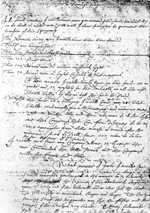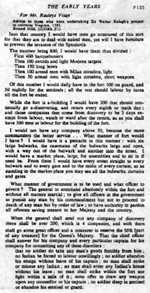
|
Mr.Rauley's [Raleigh's] voyage, 1585 - Exploration Overseas 'In
fourteen hundred and ninety-two, This document is set in the context of what older texts used to call 'voyages of discovery.' The exploration of the globe by Europeans, remains a dramatic, story-packed phase of history, whatever our views of the 'goodness' of such a movement. For youngsters whose own horizons on life are widening, there is much to identify with or react against in the exciting Tudor Voyages. In the 1990s our judgement of the colonisation of North America by Europeans is changing. It was not easy to celebrate the 500th anniversary of the 'Columbian Conquests' without feeling that somehow our junketing was treading on the sensibilities of the native Americans. There is no gain-saying the nautical skill and daring of the early European voyagers, or their physical courage and their devout religious pronouncements. But it is possible now to state that History begins in North America not with discovery, but with murder and enslavement. Columbus did so much 'for Gospel and for Gold.' This proud proclamation led to the exhaustion of the mines and the prohibition of local or native religions. Heroic voyages, when viewed from one angle, appear from another to be a cause for regret, as were Drake's coastal brutalities and Hawkins' slave expeditions. Our interpretation of this history has altered, so that in October 1992 the U.S.A. philatelic bureau felt it necessary to issue a 50 cents postage stamp depicting Mongoloid hunters as 'the first Americans crossing over from Asia,' about 12,000 years ago. Against such a back-cloth of debate, it is always instructive to turn to what was expressed at the time. This document is drawn from the Round Papers in Essex Record Office. This is a collection made by the late J.Horace Round, LL.D., historian and descendant of John Round, Recorder of Colchester c.1570-1628. It is a memorandum giving details of suggested organisation for an expedition to Spanish America entitled 'For Mr.Rauley's Viage,' [Mr.Raleigh's Voyage]. It is un-signed and un-dated, though endorsed: 'Note geven to Mr.Candishe.' This last was probably Thomas Cavendish (1560-1592), the Suffolk circum-navigator who commanded a ship in Raleigh's first and abortive attempt to colonise 'Virginia.' Raleigh was knighted in 1584, but as not allowed to go with the expedition himself.45 The manuscript relating to Raleigh's voyage was, according to Professor E.G.R.Taylor in October 1947, 'very intriguing. It does not seem referable to Virginia, where colonists and not an armed force were in question, and Spanish attack was not to be feared, but rather to Raleigh's idea of a surprise in Guiana. Here, of course, the fact that the notes are for Mr.Cavendish is a puzzle, as Thomas Cavendish was away 1586-88 and then left for the voyage in which he was lost, in 1591. Raleigh might have been anticipating his return to take military charge for his first Guiana voyage, or the Ms. might be related to some un-known project of Raleigh's for 1589-1590. The watermark in the paper seems to be of a type current 1584-1596, but my eye-sight is not good enough to identify it absolutely. I shall continue to reflect upon it!' Contemporary images of the scene may be found in the drawings of John White.46 Modern images of the encounter between 'old' world and 'new' world with an extremely youthful relevance will be discovered in the Disney film Pocahontas (1995). Some of the history behind this cartoon animation and other features of England's 'search for Cathay' can be discovered in Smith,J.R.,Pilgrims and Adventurers - Essex,(England), and the Making of the United States of America,(1992, E.R.O.Publication No.118, £7-50),pp.4-9,18-19. The abortive expedition from Harwich of 31 May 1577 by Martin Frobisher with the ships Gabriel, Michael, and Ayde to Baffin island to bring back 1,350 tons of rock streaked with gold is an interesting footnote to this history. The 'gold' turned out to be iron pyrite or fool's gold. What do the youngsters make of native Americans, 'the manner of their attire' and 'painting themselves'? In the shock of the new and different, it is easy for young people to be arrogant about differences. For 'different' read 'odd' in too many minds. It is an important corrective to remember that 'ancient Britons,' our local ancestors were a painted people. What purpose may possibly be served by the 'tail' of this 'Indian?' Do not modern folk like to take on the characteristics of fierce animals in their dress? What of the 'rockers' of our past times who were encased in their leathers? What do the children think of the term 'Indian?' This is itself symptomatic of the confusion in past European minds as to the real nature of the world in the early modern period. There are better terms for the good folk who are aboriginal to North America, ['Native Americans']. It was possible then to believe that native peoples of the New World were of India, such was the fond hope of discovering a quick passage to the supposed wealth of the far east. What was so desirable for Europeans in the far east anyway? Un-resolved doubts about the manuscript notwithstanding, and wherever 'that country' really is, there is much to appreciate in this writing of the contemporary attitude to exploration overseas. Content of Facsimile/Transcript F135: The manuscript might be examined in its original handwriting for a little while to enjoy the challenge of an unfamiliar hand. The numbers [Arabic] may be picked out and '100 fwords' [long 's' and '150 long bows' identified on lines 7 and 8 with some difficulty]. The title it is possible to decipher with children. There are features to speculate upon. Three different methods of writing the word 'have' can be noticed: line 2 with the 'h' sitting on the line as in a modern handwriting, line 11 with the 'h' flowing below the line as in many 'secretary' hands of the sixteenth century and having a loop in its upper part and compare this with the 'h; in line 14 where there is no loop in the upper portion. Why might there be these inconsistencies? No final pronouncement may be made here or by the children, but there is no reason why we cannot play the detective and try our ideas on for their size and proper fit. Do writers in any age betray inconsistencies? Could this be a document copied or 'created' afterwards? Could it be a 'forgery?' Some scepticism is healthy always, but not always at the expense of pushing historical studies forward. Ignoring the authenticity for a moment and the weak provenance for this document, even in the transcript form, this is a piece of extended writing too difficult to be left alone with the youngsters. It repays some little study beforehand by the teacher, armed with the Oxford English Dictionary, O.E.D.. What a work of reference this dictionary based on historic principles is! Begun, though not completed by James Murray, a largely self-taught Scottish Borderer, it has waiting and already un-packed for us the many meanings of unfamiliar old words.47 The O.E.D. should be deployed when reading many an old document. It is worth asking the youngsters to identify and write down the difficult words: 'harquebusier,' 'Modena targets,' 'Milan corselets,' 'sentinels,' 'pentacle,' 'bulwarks,' 'casemates,' 'curtain,' 'company,' and 'ensign.' Some of these may be copied word for word by the children. many may be provided by you the teacher:
What are the numbers involved in this exploration? How many do the pupils get when they total the figures given in lines 4 - 9 of the transcript? What portion of these 'armoured' men is the greatest? Can the impact of the gun be imagined upon the native Americans? This is not just a matter of the impact of the ball upon the human frame at some distance, it is also the psychological effect of the sight and sound of discharge - the accompanying loud noise and smoke. Spaniards would not presumably be so impressed, hence the need for 'armour.' What is the first major task upon settling in the new land? What do 200 continually go to do, whilst the fort is being built? This use of the term 'discovering,' here, which has such overtones of cultural supremacy these days, has here a contemporary use. It is interesting to find it here. What do the youngsters make of the special care taken to ensure an un-restricted view of the walls of the fort from the centre of the settlement? When the companies go out 'discovering' why do 'some great officer and a treasurer' go with them? The disorders of such a life are listed. Such 'commandments' or rules are informative. They would not be needed if such behaviour was not likely to happen occasionally? Compare these with school rules! What could happen to Indians at the hands of these European 'discoverers' then? WHAT'S MISSING
FROM THIS DOCUMENT? These fifty lines or so of instructions do not have an explicit reference to the religious dimension of early modern life. There is on line 23 mention of 'assemblies' which may incorporate Christian acts of worship. This lack of specific mention of relations with God is surprising. See for instance Instructions to Capt.John Troughton for his voyage into the Mediterranean, [E.R.O. reference D/DP O3], in which the first instruction was 'First and above all thinges in the wholle course of your servyce wee wysh you to govern your Company in the fear of God and exercise of Divine Service'.48 If hard-bitten sailors could be reminded in their instructions of their duties to God, then surely hard-nosed soldiers would be too? However, absence of information cannot be reliably taken as proof of anything vital.
|
||||||||
 |

